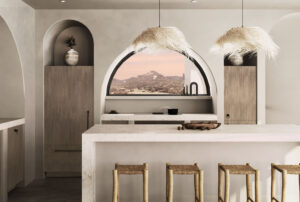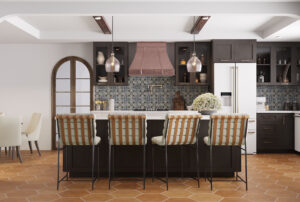What if the key to a serene home is to find beauty in the imperfections you’ve overlooked? Wabi sabi interior design celebrates these unique quirks through the use of natural textures, subtle hues, and thoughtful arrangements. This guide reveals how to master the wabi sabi approach, transforming your space into a haven of calm and beauty, rich with imperfection.
Key Takeaways
- Wabi Sabi is a Japanese philosophy that finds beauty in imperfection, promoting the appreciation of aging objects and the use of natural materials like wood and stone in design.
- Key elements of Wabi Sabi interior design include the use of natural materials, earthy tones, simplicity, minimalism, and the incorporation of asymmetry and irregularity to create a sense of peace and authenticity.
- Sustainability is a central aspect of Wabi Sabi, emphasizing recycling, reusing, and repurposing to create interiors that are eco-friendly and cherish the imperfect, complemented by other harmonious design styles like Japandi, Zen, and Rustic.
Understanding Wabi Sabi Philosophy

Wabi Sabi is a captivating Japanese philosophy rooted in Zen Buddhism that cherishes the beauty inherent in life’s imperfections. The wabi sabi aesthetics encourage appreciation of the innate beauty of both animate and inanimate objects, even when they exhibit signs of age or wear.
This unique perspective has reached far beyond Japan, inspiring designers and artists worldwide. Influential figures like Marie Kondo have recognized the significance of Wabi Sabi in guiding our choices for selecting and arranging items in our homes, reflecting a positive approach to life.
Key Elements of Wabi Sabi Interiors Design
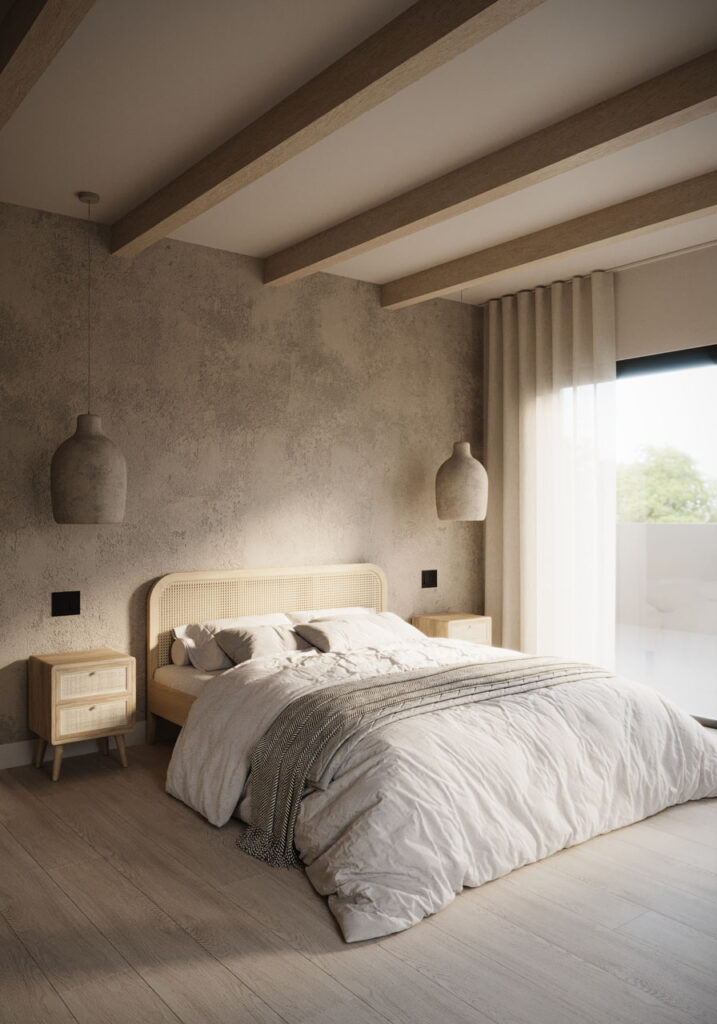
Wabi Sabi design is characterized by four key elements that work together to create a serene and harmonious living space. These elements are:
- Natural materials
- Earthy tones
- Simplicity and minimalism
- Asymmetry and irregularity
We’ll explore each of these elements in detail in the following subsections.
Natural Materials
The use of natural materials such as wood, stone, and linen is integral to a Wabi Sabi home, as they infuse the space with a sense of warmth and authenticity. These materials, which are often used in furniture and home decor, beautifully emphasize the wonders of the natural world. You can also incorporate houseplants and items made from natural and raw materials into your decor to create a soothing and organic atmosphere.
Washed linens stand out for their ability to augment the beauty of Wabi Sabi design, contributing to a cozy and welcoming ambiance. These linens, with their natural textures and colors, contribute to the overall aesthetic of the space and perfectly embody the Wabi Sabi appreciation for the imperfect and the transient.
Earthy Tones
A signature of Wabi Sabi interiors is their wonderfully muted and neutral color palette, which showcases earthy tones such as gray, brown, and white. These colors create a calming and lived-in atmosphere, making spaces feel inviting and cozy. Sage green, rusty orange, and stone gray, are also cherished in Wabi Sabi design for their strong connection with nature and the serene atmosphere they create.
The affinity for earthy tones is deeply entrenched in the design philosophy of Wabi Sabi. These colors play a significant role in enhancing the natural essence, adding a touch of raw beauty, and perfectly complementing the celebration of imperfections and simplicity. Some of the earthy tones commonly used in Wabi Sabi design include:
- Warm browns
- Soft greens
- Earthy grays
- Natural beiges
These colors help to create a natural and calming aesthetic that is both serene and visually appealing.
Simplicity and Minimalism
The principles of simplicity and minimalism stand out as fundamental elements of Wabi Sabi design, as they advocate for focus on essentials, clutter reduction, and the accentuation of meaningful and functional items. This focus on simplicity creates a clean and peaceful living space that radiates tranquility and harmony.
Minimalism in Japanese culture, and particularly in Wabi Sabi design, plays a significant role in celebrating the beauty found in imperfections and the fleeting nature of life. This minimalist approach, rooted in Japanese aesthetics and influenced by Japanese art, promotes simplicity, modesty, and an appreciation for the natural ebb and flow of existence, creating spaces that are not only visually pleasing but also profoundly meaningful in the context of Japanese design.
Asymmetry and Irregularity
Asymmetry and irregularity as embraced in Wabi Sabi design infuse spaces with character and uniqueness, largely through the unconventional arrangement of furniture and decor items. This embrace of the irregular and the imperfect creates a charming and distinctive ambiance, a testament to the Wabi Sabi appreciation for the beauty of imperfection.
Incorporating asymmetry into a Wabi Sabi interior can be achieved through carefully selected decor with unique and uneven shapes and a naturally aged appearance. Furniture arrangement could also embrace imperfect balance for a more organic and dynamic feel. This approach not only creates a visually interesting and inviting environment but also reflects the core principles of the Wabi Sabi philosophy.
Creating a Wabi Sabi Living Room
When embarking on the design of a Wabi Sabi living room, it is essential to incorporate natural materials such as wood, stone, and organic fabrics like linen or cotton. These materials add warmth and authenticity, creating a cozy and inviting atmosphere. Even the flooring can enhance the Wabi Sabi aesthetic. Consider earthen floors or carpeting in earth tones to create a grounding and cohesive look.
The furniture in a Wabi Sabi living room should have clean lines and minimal ornamentation. This approach creates a beautiful sense of simplicity and calm within the space. As for the color scheme, muted earth tones such as beige, taupe, and gray are perfect for creating a calming atmosphere.
Designing a Wabi Sabi Bedroom

Creating a Wabi Sabi bedroom involves emphasizing simplicity, utilizing natural fabrics, and maintaining clean lines. Think of furniture made from natural wood or metal, bedding made from linen or cotton, and decor items that reflect the natural world. Bamboo, cotton, and linen are all wonderful natural fabrics that beautifully suit a Wabi Sabi bedroom design.
Handcrafted items, artisanal pieces, and furniture made from natural and raw materials are perfect embodiments of the Wabi Sabi philosophy. These can be complemented with textiles and bedding that embrace a naturally imperfect look, such as leaving the bed imperfectly made.
Crafting a Wabi Sabi Kitchen
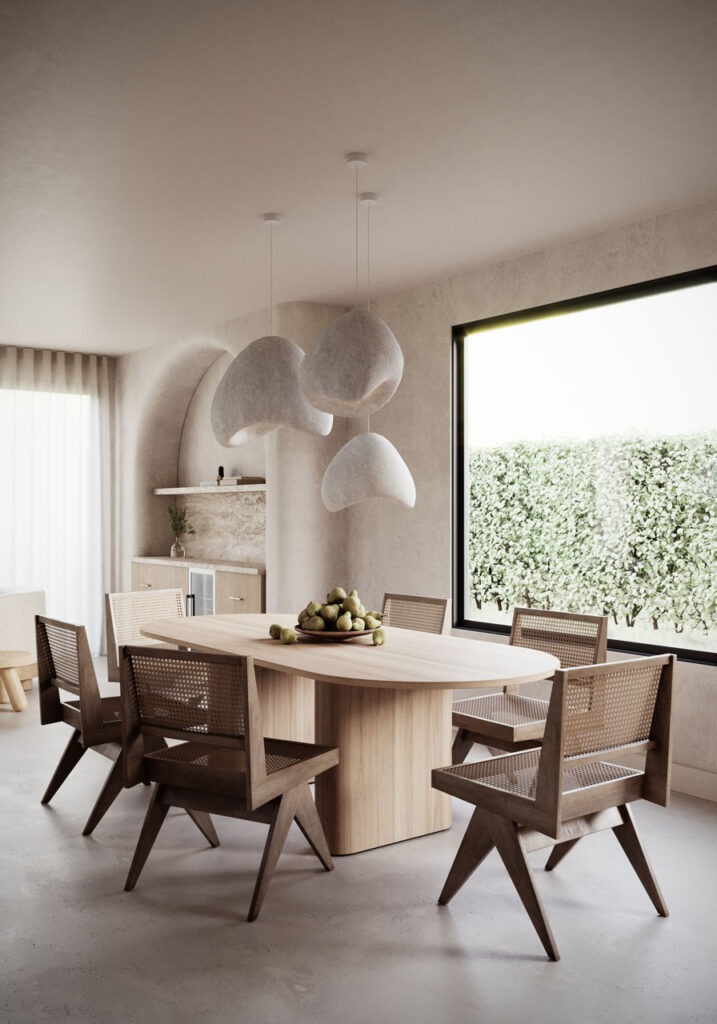
To create a Wabi Sabi kitchen, it is essential to use natural materials such as wood, stone, and bamboo, complemented by a calming, earth-toned color palette. Handcrafted elements like pottery, ceramics, and woven textiles add a unique and personal touch, embracing natural textures and creating a soothing and organic atmosphere.
Sustainability is a key principle of Wabi Sabi design. In a Wabi Sabi kitchen, this principle is beautifully realized by:
- Repurposing older or broken items
- Embracing imperfections by using chipped or cracked dishes as decor
- Recycling or reusing discarded items to minimize environmental impact and add an authentic touch.
Wabi Sabi Bathroom Inspiration
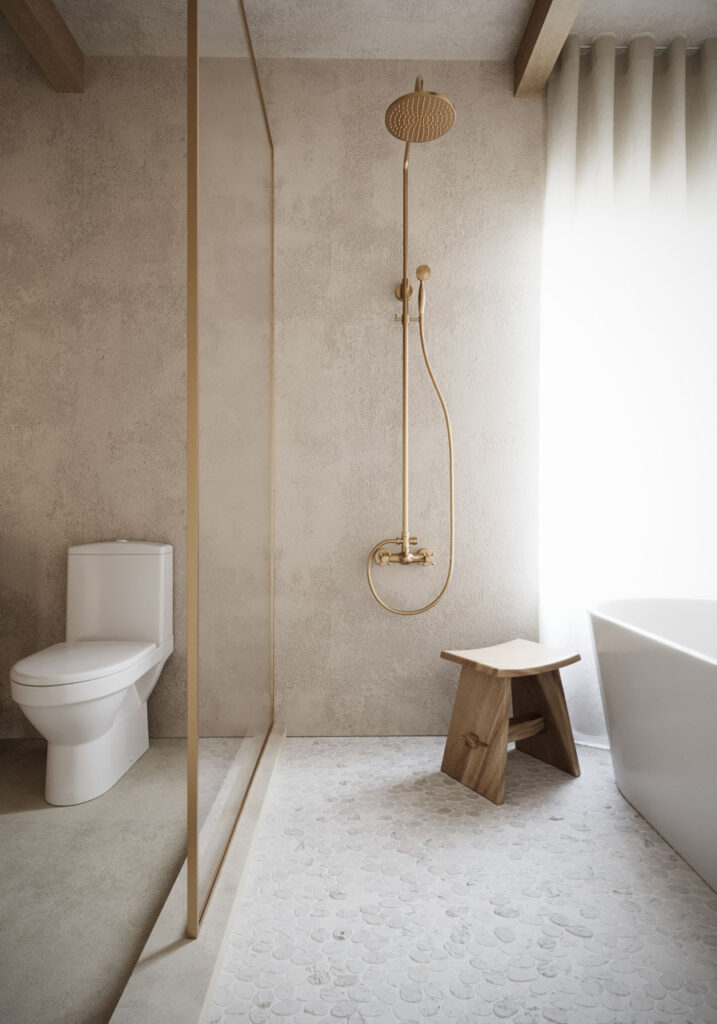
The design of a Wabi Sabi bathroom calls for:
- the use of natural materials such as stone or wood for an accent wall
- bamboo, ceramic, leather, and raw metals to foster a warm and tranquil ambiance
- fixtures that embody a minimalist aesthetic with simple, clean lines.
Natural lighting also plays a crucial role in a Wabi Sabi bathroom. Some ways to incorporate natural lighting are:
- Installing large windows with minimal coverings
- Adding skylights to bring in more light
- Using light-colored curtains or blinds to allow maximum light
- Placing mirrors strategically to reflect natural light
In addition, adding plants like succulents and bamboo can enhance the serene and organic ambiance of the space.
Sustainable Practices in Wabi Sabi Design
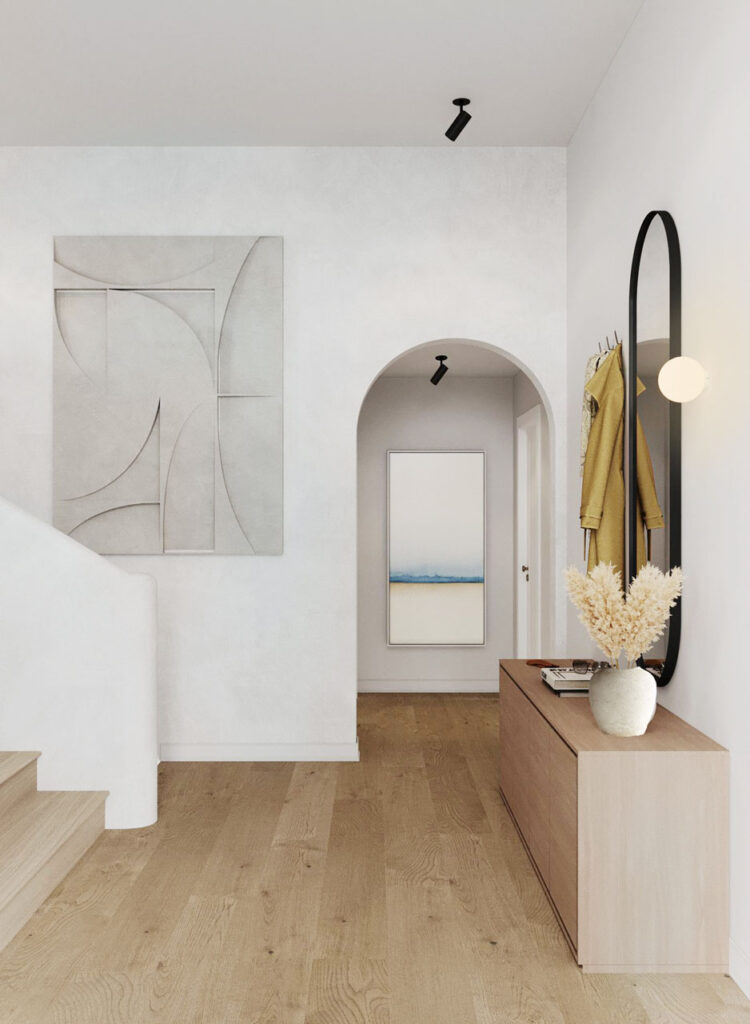
Sustainability is a fundamental aspect of Wabi Sabi design. It involves:
- Recycling and reusing ‘rubbish’
- Fixing damaged items at repair cafes
- Repurposing furniture
- Highlighting imperfections
- Using broken or raw elements such as pared-back flooring, raw concrete walls, and unpolished wooden surfaces
All of these practices contribute to a sustainable approach.
Embrace imperfection and enable the use and celebration of natural, sustainable materials that age beautifully and reduce the need for constant replacement, thereby minimizing waste. This approach aligns perfectly with the Wabi Sabi design philosophy, which cherishes the beauty inherent in life’s imperfections. Natural materials such as:
- wood
- stone
- linen
- cotton
- other eco-friendly materials
are the cornerstone of this philosophy.
Complementary Design Styles
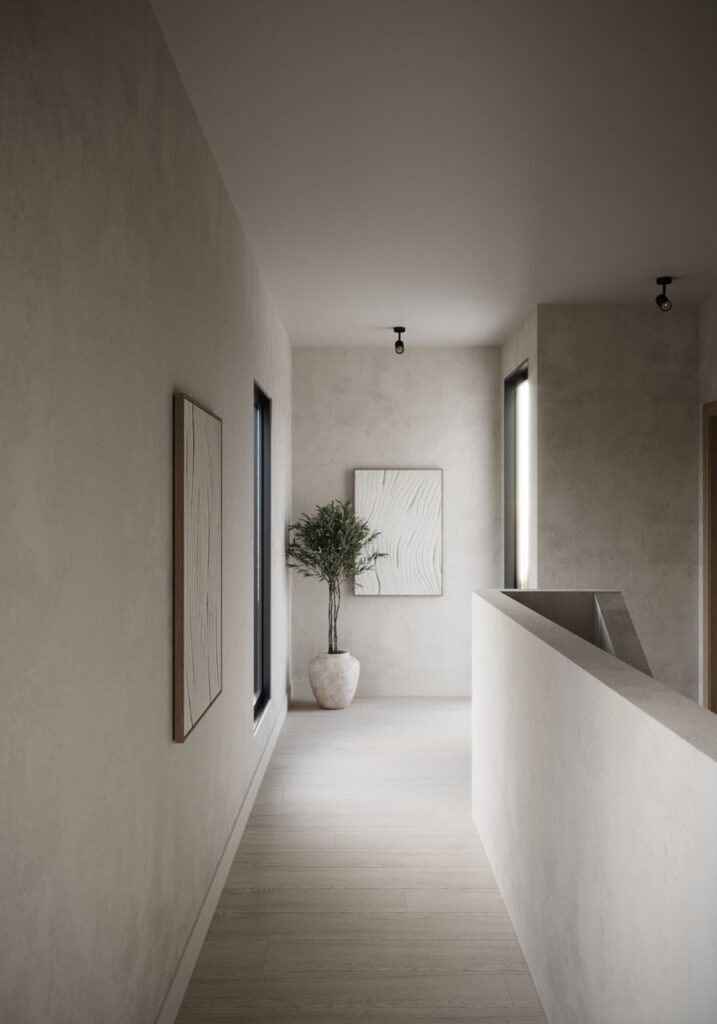
A number of design styles harmonize well with the Wabi Sabi aesthetic, including the wabi sabi style itself and others such as:
- Japandi, which merges the Japanese aesthetic of Wabi Sabi with Scandinavian minimalism, balancing minimalism and ornamentation through minimalist furniture design that focuses on texture and grain.
- Zen, which emphasizes simplicity, natural materials, and a sense of tranquility.
- Rustic, which embraces imperfections and natural elements, such as wood and stone.
These interior design aesthetic style choices can help create a Wabi Sabi-inspired space that celebrates imperfection and the beauty of the natural world.
Zen design emphasizes minimalism, tranquility, and the use of similar natural materials, aligning with the Wabi Sabi appreciation for imperfection, aging, and patina.
Rustic design, on the other hand, connects to the Wabi Sabi philosophy through its use of natural materials like wood and stone, and its overall aesthetic that values simplicity, authenticity, and the appreciation for natural beauty and imperfection.
Summary
In conclusion, Wabi Sabi is a unique design philosophy that celebrates the beauty of imperfection, simplicity, and nature. Its principles can be applied to every room in your home, creating a tranquil and harmonious living space. By embracing imperfections, reducing clutter, and focusing on natural materials and earthy tones, you can create a home that is not only visually pleasing but also profoundly meaningful.
Frequently Asked Questions
What is wabi-sabi interior design?
Wabi-sabi interior design celebrates imperfection and embraces organic, sustainable materials. It emphasizes irregular, raw textures and flawed finishes, creating a sense of warmth and approachability. This design ethos is the epitome of sustainable design and modern organic living.
What are the rules of wabi-sabi interior design?
Wabi-sabi interior design embraces asymmetry, simplicity, and natural elements like plants and raw materials, while rejecting the idea of perfection. It centers around what’s natural and real. Embrace the philosophy by opting for asymmetry, minimalism, and natural touches.
What are the colors of wabi-sabi interior?
In wabi-sabi interiors, you’ll find muted, earthy tones like sage green, rusty orange, and stone gray, creating a calming and neutral palette for an anchored atmosphere.
What are the principles of wabi-sabi design?
In wabi-sabi design, principles include sparse furniture arrangements, open floor plans to create spaciousness, and the use of multi-functional objects for clutter-free spaces. Embracing these principles can bring a sense of simplicity and beauty to your living space.
How can I incorporate Wabi Sabi design in my living room?
Incorporate Wabi Sabi design in your living room by using natural materials like wood and stone, clean-lined furniture, and a calming color scheme of muted earth tones. Embrace simplicity and imperfection for a serene and harmonious atmosphere.

